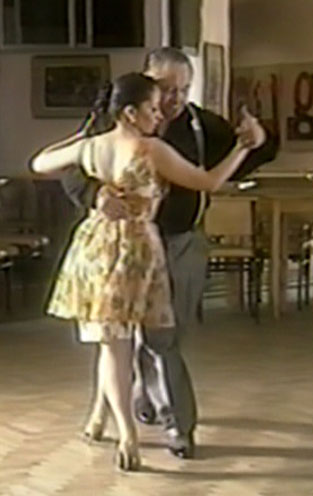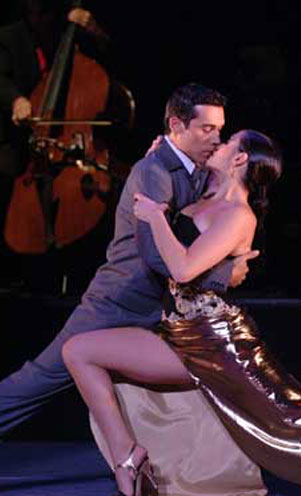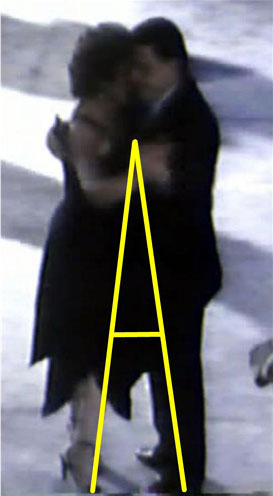Ground Rules
The Limits of Tango Salon
In this chapter we’ll be talking about some of the specific techniques needed to dance tango. But first, let’s quickly define exactly what it is that we’ll be discussing.
Tango is divided into two parts: Stage tango and social tango:
Social tango is sometimes called tango milonguero, meaning tango for the milonga, or tango salon, meaning tango for the dance salon—but they are the same thing.
Stage tango is called tango escenario or tango fantasia in Argentina, although today it’s also being taught under variations labeled tango nuevo, or tango alternativo.
The two tangos are different in several ways. Because many tango instructors mix the two together, it's very important to understand the differences—so let’s take a look at a short video that shows them:
The basic differences between stage and social tango should be clear. The video begins with Miguel Balbi and his partner, and Alberto Dassieu and Elba Biscay. All are milongueros. Then Gustavo Naveira and his partner Giselle are shown dancing stage tango. You can see right away that he picks up his feet, kicks, and moves his left arm around more than the milongueros. He and Giselle also separate and do large leg swings and poses. Unlike the milongueros, they move their bodies around, and dance apart from each other. It's a more physically active and demonstrative way of dancing because it's designed to entertain an audience: Stage tango.
Miguel Balbi is dancing tango salon. He stays close to hi partner, he keeps his feet close to the floor, and his left arm remains still. He maintains an upright posture without a lot of leg flexing, and he looks so smooth and relaxed that he could be taking a mate as he dances. He moves in a predictable way that wouldn't bother someone dancing right next to him. This is the tango we'll be covering in this chapter: Tango for the dance salon. Tango milonguero... social tango.
[The other two milongueros dancing are Jorge Uzunian dancing with Haide, who comes on right after Alberto and Elba, and also Haide's brother, Oscar Hector from Glorias Argentinas, with Teresita Brandon, who appear at the end.]
Intelligent Design v. Evolution
It’s fairly easy to see the differences between stage and social tango just by watching people dance. But if you look beneath the surface, you'll find other differences. Stage tango is the result of conscious planning. It's made up mostly of figures and steps that were intentionally designed by people for the purpose of entertaining other people. Social tango, on the other hand, is the result of natural selection. Like organisms that exist in the natural world, social tango has been shaped and polished over the years by the conditions that surround it. Social tango was shaped by the environment of the milonga, and you can't separate them. Social tango and the milonga are meaningless without each other.


Maestros Suzuki y Pepito Avellaneda (left), and stage dancers.
There is also a basic philosophical difference between the two tangos. The goal of social tango is to express Golden Age tango music in a milonga. And while some of us may like to watch it, entertaining the people sitting around the floor is not really its goal. We’ve probably beaten this point to death here, but I think most of the problems with tango outside of Buenos Aires stem from an inability (or unwillingness) to really understand these differences. And it's almost certain that if you've taken tango classes from anyone other than the handful of teachers who really know how to dance in the clubs (I know...they all say they do... but most of them don't), then it's almost certain that you've been exposed to a lot of tango that was never meant to be danced in a milonga.
Which style is more elegant? I'm sure most people would say stage tango. Which is understandable, because like jewelry, or a Rolls Royce, it's designed to look flashy and elegant. That's the whole point. But there are other types of beauty. For instance, there is beauty and elegance in the solution of a problem—like the beauty in good ski racing, or the lines of a sailing ship. So let's look at social tango as the solution to a problem—an engineering problem posed by the environment of the milonga.
The Geometry of the Embrace
Two people dancing together in a milonga face several challenges. They must be able to dance comfortably close to other dancers in a restricted space that's constantly moving and changing shape. Furthermore, they need to use two different parts of the body to express the music. The feet express the compás of tango by stepping on the cadences of the music, while the upper bodies express the melodic sentiment—usually by moving around the floor, or by turning in place. Finally, one partner has the job of moving to the music and leading, while the other partner's job is to follow smoothly and efficiently (and occasionally to help with navigation). This is basically an engineering problem—and the best biomechanical solution is the modern tango embrace.
In the milongas today, couples usually embrace facing each other, with their upper bodies connecting at the chest, and their feet separated sufficiently to leave space for stepping:

Tango as the solution to an engineering problem: To understand the structure of
social tango, you need to look at the conditions that formed it. (Maestros Teresa y Fino)
The modern tango embrace provides a solution to several problems. By embracing with the upper bodies and connecting at the chest, the woman can instantly feel the direction of the leader's upper body movement, and she can also feel the cadence of his steps. Since only the upper bodies are connected, the legs and lower bodies of the partners remain free to express the cadences of the music.
Social tango, is really made up of three different dances. The man dances one combination of cadences with his own feet, while leading a different combination of cadences for his partner's feet. In addition, he uses his upper body to express the melody. While the feet of each partner dance separate cadences, the melodic sentiment of the music is expressed together in the upper bodies of both partners. We'll discuss this in more detail later, but for now, we'll just say that this is a formidable task. Being able to express all of these three different dances well—and simultaneously—in a crowded milonga is a tough job. It requires very solid technique.
The width at the bottom of the A-frame embrace gives each partner room to step independently, both inside and outside of the embrace. And the close connection of the upper bodies allows the man to transmit the subtleties of his compás, as well as a separate compás for his partner. In addition, it allows a third channel of communication for the melody. An accomplished couple can do all of this comfortably and creatively in a surprisingly small space.
Of course, whether the space is large or small, nothing remains static in a milonga. Available space is constantly moving and changing, so a good dancer needs to move with it. The A-frame embrace creates a solid biomechanical structure that allows the man's body to efficiently carry his partner forward as he steps. It allows his partner to comfortably and quickly match the length of any step he takes—and like any well designed system, the parts are durable and interchangeable. Each dancer can change partners and music without losing the ability to communicate and move efficiently.
But there is one important caveat: This embrace does not work well without good posture! Poor posture prevents clear communication between the partners, and it limits the ability of the couple to move smoothly around the floor. And it's also contagious. One partner's bad posture can be uncomfortable for both. So let's go to the Posture Page.
[A note on terminology: We use the term A-frame embrace here, but sometimes the word apilado is used. It's a good descriptive word, because in this case, it means "stacked up"—the way you might lean folded patio chairs against each other. The problem is that the word is often misused. Like tango milonguero, some people began to assume that apilado referred to a specific style of tango. It doesn't. There are two styles of tango: social and stage. There is no separate apilado style or milonguero style, any more than there is a separate ocho style, or giro style. Apilado merely refers to one element of the kind of tango danced in the milongas, and most good dancers use it to some degree. In stage tango, where space and choreography preclude the need for quick mobility and spontaneous communication, performers may also lean into each other—sometimes in a very exaggerated way—but it's really done for style reasons. In the milongas however, it's the solution to a biomechanical problem.]